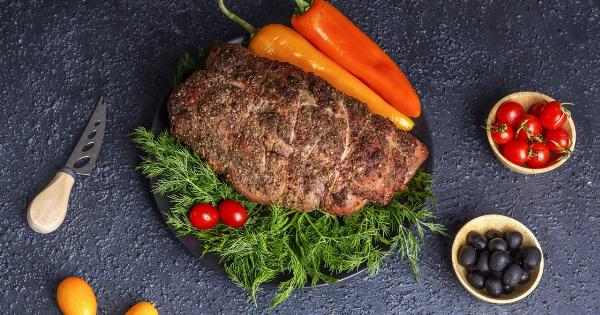Olives, a popular Mediterranean fruit, have been enjoyed by many for their unique flavor and numerous health benefits.
While olives are generally considered safe to consume, it is essential to understand that certain types of olives may carry potential risks and dangers when consumed in excess or in specific health conditions. In this article, we will explore the potential dangers of eating red olives, their associated risks, and the side effects they may have on your health.
1. High Sodium Content
Red olives, like most varieties of olives, are often preserved in brine or saltwater, resulting in a high sodium content.
While sodium is an essential mineral that helps maintain fluid balance in our bodies, excessive intake can lead to health issues like high blood pressure, heart disease, and stroke. Individuals with hypertension or cardiovascular conditions should be cautious when consuming red olives, as they may need to limit their overall sodium intake.
2. Digestive Issues
Consuming excessive amounts of red olives can cause digestive issues due to their high fat content and fiber composition. Olives contain monounsaturated fats, which are generally considered healthy fats.
However, when consumed in excess, these fats can cause bloating, gas, and diarrhea in some individuals. Additionally, the fiber content in olives may lead to digestive discomfort, especially in those with sensitive digestive systems or those prone to irritable bowel syndrome (IBS).
3. Allergies and Sensitivities
Although relatively rare, some individuals may be allergic to olives, including red olives. Allergy symptoms can range from mild to severe and may include itching, swelling, hives, difficulty breathing, and even anaphylaxis in severe cases.
If you experience any allergic reactions after consuming red olives, it is vital to seek medical attention immediately. Additionally, individuals with existing sensitivities or allergies to other fruits or botanicals may have a higher risk of developing an olive allergy.
4. Oxalate Content
Red olives, along with several other foods, contain oxalates. Oxalates are naturally occurring compounds found in plants that can form crystals and potentially contribute to the formation of kidney stones in susceptible individuals.
If you have a history of kidney stones or are at risk of developing them, it may be advisable to moderate your consumption of red olives or consult with a healthcare professional for personalized guidance.
5. Interference with Medications
It is essential to be aware that certain medications can interact with red olives and their components. For example, red olives contain vitamin K, which plays a crucial role in blood clotting.
If you are taking anticoagulant medications, such as warfarin, it is vital to maintain a consistent intake of vitamin K-rich foods like red olives to avoid fluctuations in medication effectiveness. Always consult with your healthcare provider or pharmacist about any potential interactions between your medications and red olives.
6. Elevated Calorie Content
While red olives offer various health benefits, they are relatively high in calories when consumed in large quantities. Each olive contains approximately 5 to 10 calories, and it’s easy to indulge in a significant number of olives in one sitting.
Overconsumption of red olives, especially when combined with other high-calorie foods, can lead to weight gain and hinder weight loss efforts. It is essential to practice portion control and include red olives as part of a balanced diet.
7. Sodium Content in Blood Pressure Management
Individuals with high blood pressure or those following a low-sodium diet should be cautious when consuming red olives. The high sodium content in red olives can interfere with blood pressure management efforts and overall heart health.
If you have hypertension or cardiovascular issues, consider limiting your intake of red olives or opting for low-sodium alternatives.
8. Pesticide Residue
Conventionally grown red olives may carry pesticide residue, which can have potential health risks. Pesticides are chemicals used to control pests and diseases in agricultural practices.
Consuming foods with pesticide residue may contribute to chronic health conditions or affect the body’s natural detoxification systems. Whenever possible, choose organic or pesticide-free red olives to minimize exposure to potential harmful chemicals.
9. Salicylate Sensitivity
Red olives, as well as other fruits and vegetables, contain salicylates, which are natural compounds involved in the plant’s defense mechanisms.
While most individuals can tolerate salicylates without any issues, some may have a sensitivity or intolerance to these compounds. Salicylate sensitivity can cause symptoms such as nasal congestion, skin rashes, headaches, and gastrointestinal distress.
If you suspect a salicylate sensitivity or experience these symptoms after consuming red olives, it may be necessary to avoid or limit their consumption.
10. Contamination Risks
Although rare, there is a potential risk of contamination associated with red olives, particularly if they are improperly handled or stored.
Contaminants such as bacteria, molds, or yeasts can multiply rapidly in olives, especially if they are not stored at the appropriate temperatures or if the container is not adequately sealed. It is crucial to purchase red olives from reputable sources, check the packaging integrity, and follow proper storage guidelines to minimize the risk of contamination.
In conclusion, while red olives offer a range of nutritional benefits, it is important to be aware of the potential dangers associated with their consumption.
High sodium content, digestive issues, allergies, oxalate content, medication interactions, elevated calorie content, and pesticide residue are among the risks that should be taken into consideration. Additionally, individuals with high blood pressure, salicylate sensitivity, or a history of kidney stones should exercise caution when consuming red olives.
By understanding these potential dangers and making informed decisions, you can enjoy red olives as part of a balanced and healthy diet.































